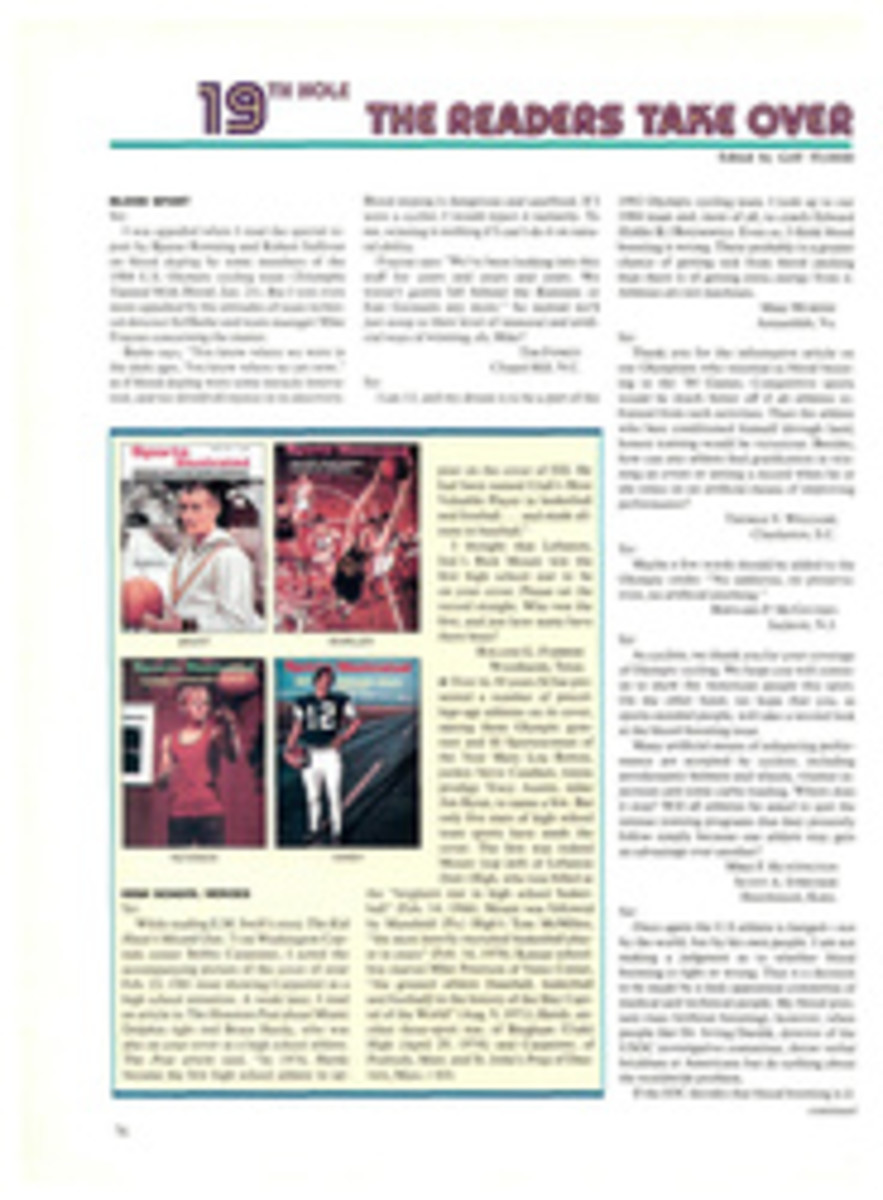
SCORECARD
WILL THE FLOW FROM RUSH CREEK SWAMP THE DREADED DWP?
The Los Angeles Department of Water and Power has been an intimidating force since the early 1900s, when it seized control of the water in the Owens River in Inyo County, 240 miles north of L.A. in the eastern Sierra Nevada, so that big landowners could develop semiarid Southern California. In 1924, angry farmers in the Owens Valley, faced with ruin from loss of water, dynamited the department's aqueduct and redirected its flow back into the river. But that didn't stop the DWP, which after repairing the aqueduct resumed diverting water from the Owens River and, in the 1930s, took over more water in Inyo County and neighboring Mono County. By 1940 the DWP had turned Inyo and Mono counties into virtual satrapies whose streams and rivers were siphoned off to booming Southern California.
But now the DWP is facing an unaccustomed challenge to its swaggering authority. The challenge revolves around Rush Creek, a once legendary trout stream in the high Sierra between Grant Lake Reservoir and Mono Lake that had long been dry because of the diversion of its water to L.A. From 1981 to 1983, unusually snowy winters and wet summers resulted in lower Rush Creek springing to life with spillover released by the DWP from the reservoir. Last October, Dick Dahlgren, a real-estate broker and president of Mammoth Fly Rodders in nearby Mammoth Lakes, visited Rush Creek and was astonished to find it stuffed with brown, brook and rainbow trout. Using a dry fly, Dahlgren had a strike about every 90 seconds. The fish had obviously come with the reservoir's surplus flow. Biologists in the state Department of Fish and Game estimated that 30,000 to 50,000 trout inhabited the 10-mile-long stream, with more than 7,000 fish per mile in the upper stretches.
Dahlgren shared news of his discovery with Barrett W. McInerney, a vice-president of California Trout, a fishermen's group, who owns a summer cabin in the area. A couple of weeks later Dahlgren and McInerney learned that with the return of normal weather conditions, the DWP again coveted Rush Creek's water and was about to turn off the flow. The two mounted a campaign to save the creek. "We begged just about every elected official in the state to spare the fish until spring, when the snowpack could be measured," McInerney says. "They were interested only until they heard the initials DWP, and then the phone calls weren't returned." At first the DWP took the matter lightly. Dahlgren tells of a conversation he had with Duane L. Georgeson, DWP assistant general manager for water, after L.A. councilman John Ferraro asked that DWP keep water flowing into the creek. According to Dahlgren, Georgeson told him, "We answer to no one." Georgeson denies using those words, although he does say, "I did my best to explain to [Dahlgren] that we were going to discontinue the flow."
Eager to prevent that from happening, McInerney, a former L.A. County deputy district attorney, began reading the state Fish and Game Code, page by page, in the hope of finding a legal hook. "Lo and behold," he says, "I discovered a bill passed in 1937 that required a dam owner to release sufficient water over, around or through the dam to keep in good condition any fish that might exist below the dam. There was no cross reference in the main code to this section—you had to go through the whole code to find it."
Cal Trout quickly asked for a temporary restraining order in Mono County Superior Court to stop the DWP from diverting water from Rush Creek. On Nov. 20 Judge Donald Chapman granted the request and ordered a trout-saving minimum flow of 19 cubic feet per second, pending a full trial this spring.
More will be at stake in that trial than the fate of Rush Creek. McInerney says, "Rush Creek has become a battleground that could rewrite all the water agreements in California to the benefit of the fisheries. Nobody wants to turn Southern California back into a desert. All we want is to have the leverage to force the DWP to become accountable for its actions in the eastern Sierra." A suddenly alarmed DWP agrees that the lawsuit could have "cascading" effects, and its officials raise the specter of water shortages in Southern California if it loses.
But if the prospects are really so dire, why doesn't the DWP exercise its renowned clout and seek to have the California legislature change the law? One probable answer is that it doesn't want to further undermine its already shaky position in the pending Rush Creek court case. The awkward fact is that the DWP hasn't always bothered to demonstrate an overriding need for all the water it draws from afar—and it certainly hasn't always demonstrated a right to it. Until it does, the fishermen vow to keep pounding away at what McInerney calls "the arrogant, egotistical bastards" in the DWP. "We play the role of the mongoose," McInerney says. "The more they shake, the deeper we bite."
—ROBERT H. BOYLE
DEGRADING DECISION
Now some news about another embattled fish habitat. Colonel Fletcher H. Griffis, district engineer for the Army Corps of Engineers, said last week that he intended to issue a landfill permit for construction of Westway, a highway-real-estate development along the Hudson River on Manhattan's West Side. Westway has been held up for years, in part because of abundant evidence that it would have an adverse impact on an important winter habitat of striped bass, a species whose North Atlantic stock is in sharp decline (SCORECARD, July 12, 1982, et seq.). To judge by Griffis's decision, which is subject to review—and, one would hope, veto—by Army higher-ups and the Environmental Protection Agency, the official obfuscation that for years has dogged the project is continuing.
Instead of acknowledging Westway's likely harmful effect on the striped bass's Hudson River habitat, Griffis asserted that a conclusive scientific determination of the project's impact was "beyond the state of the art." However, even that dubious finding should have resulted in denial of the permit, because, as Griffis noted, the law places on Westway's promoters the burden of proving that the landfill would "cause no significant degradation to the aquatic environment." By giving his go-ahead, Griffis was saying, in effect, that the pro-Westway forces had proved what he said couldn't be proved.
FINISHING TOUCH
The Quebec government announced last week that Montreal's Olympic Stadium will finally get the retractable roof that was to have been part of the stadium when it was built for the 1976 Summer Games. The stadium was rendered roofless after its cost, originally estimated at $100 million or so, soared to $700 million, leaving the province deep in debt. The roof, which is expected to be completed in 1987, will cost $125 million. In Vancouver, where an entire domed stadium was completed in 1983 for $125 million, The Province reported the news from Montreal with this deft headline: CHAPEAU FOR THE BIG OWE.
THE GAME WAS A NON-THRILLER
When college basketball's defending national champion has a point guard with the same name as the nation's No. 1 pop star, this sort of thing is probably inevitable. After his team was annihilated 80-46 by Georgetown, Southern Connecticut coach Art Leary was asked why he'd scheduled the powerful Hoyas. He replied, "My son wanted to see Michael Jackson."
A WEIGHTY QUESTION
Miami Dolphin coach Don Shula was talking to reporters before the Super Bowl about running back Pete Johnson, whose weight has ranged between 250 and 280 pounds this season. With great assurance, Shula said, "Next season, Johnson will report to camp at 225."
"A.M. or P.M.?" asked one wise guy.
MUSCLES AS HARD AS ICE—AND VICE VERSA
Don't be misled by this photo: Our annual swimsuit issue doesn't come out till next week. The women posing in the snow are (from left) bodybuilders Gladys Portugues, Bev Francis, Carla Dunlap and Lydia Cheng, who were on the Dartmouth campus in Hanover, N.H. for the world premiere two weeks ago of the movie Pumping Iron II: the Women. Charles Gaines, author of the Pumping Iron books, is a New Hampshire resident, as are George Butler, who took the photographs used in the books and directed the movies based on them, and the backers of the new film, whose production company is called White Mountain Film. Therefore, a Granite State premiere was a natural. Besides, Dartmouth is home of the most celebrated collegiate winter carnival, so there was no trouble coming up with an ice sculpture suitable for the occasion.
PHOTO
DICK DAHLGREN
High waters brought thousands of trout, including this brown.
PHOTO
STUART BRATESMAN
THEY SAID IT
•Harry Neale, coach of the 12-32-7 Vancouver Canucks, shrugging off complaints that his workouts are too tough: "I know my players don't like my practices, but then, I don't like their games."
•David Letterman, NBC-TV late-night host, reflecting on the Super Bowl XIX telecast: "If the game proved one thing, it's that Tom Landry should wear a hat."
•Jim Durham, Chicago Bulls' radio play-by-play man, talking to 6'11" center Dave Corzine about the Utah Jazz's 7'4" Mark Eaton: "If you go to the movies with him, they'll let you in for half price."
•Bob Hallberg, Chicago State basketball coach, whose team is playing only nine of its 27 games at home: "The only person who likes our schedule is my 17-year-old son, Bob. He gets the car whenever I'm out of town."

